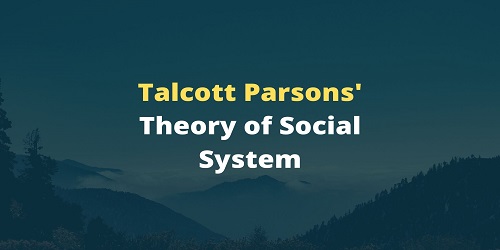Talcott Parsons’ Theory of Social System:
The central point of Parsons’ analysis of social systems is the problem of order. He believed that all social systems came into existence because people within these systems wanted order and stability.
A social system, according to Parsons, existed when two or more people interacted with each other in a bounded situation and their actions influenced others. This means that a social system must, first of all, have a group of people. This group could comprise two individuals or even a country. Secondly, these people exist within a common boundary. Thirdly, they interact with each other, either directly or indirectly. And lastly, their actions influence each other’s behavior.
Therefore we can assume that the action of any person is determined by whom he or she is interacting with. This in turn is determined by the rules of behavior in a particular society or social system. The rules of behavior are further based on the common consensus of the people and that is why it is taken as correct. This common consensus is what Parsons calls Values. Social values are therefore the shared beliefs of a society.
The way in which these values are practiced (the actions which result from forming these values) are known as Norms. Social norms are thus the rules of behavior. Parson further states that social values and norms arise out of the need for every society to maintain order and stability.
Values and norms will differ in each society because the needs of each society are different. But the common factor in the value system of each society is the need for stability. Hence each society devises its own values which are best suited for this purpose.
Value Consensus and Stratification:
How does me value system of society emerge? Parsons attempts to answer this question by stressing that values do not arise out of the mind of an individual (king or priest in earlier times). Values are shared beliefs. This means that all members of a society agree that the given values are the best means through which stability can be maintained in their society. In this way, values are not only shared beliefs but emerge out of the consensus of the members of mat society. This consensus emerges because all members of society want order and stability in their daily life. Therefore, order stability mid-cooperation is based on the value consensus.
In any society, those performing according to social values are better rewarded. The type of reward, according to Parsons, depends on what the values of that society define as superior. For example, traditionally among the Rajput high value was placed on braver and valor. Hence, any person displaying these qualities was better rewarded and given a higher rank. Similarly, in all societal systems, the value system places higher rewards on some qualities and lesser rewards for other qualities. In case a person violates social values he or she is punished. Hence in a society that places greater values on bravery a person who shows traces of cowardice will lose rank.
Modern industrial societies, according to Parsons, places a higher value on individual achievement. Moreover, the emphasis of such societies is on producing goods and services. Hence, Parsons noted that in these societies (especially the USA) the value system places “primary emphasis on productive activity within the economy.” Thus, those who excel in these will be better rewarded. This in turn elevates their position in the stratification system. Therefore we can see that in explaining social stratification, Parsons placed emphasis on the differences that existed among people. These differences, he explained, were in consonance with the value system of that society and hence were necessary for the stability of that society. These differences may cause conflicts but since they are backed by the value system, there are few instances of intensive conflict over these issues. Hence, Parsons argued, the people by and large accept these differences, and major conflict is prevented.
All people, whether they be workers or in management, believe that this system is the best. If these values are challenged this would lead to instability in that society.
Therefore we can summarize Parsons’ main points thus:
- Value consensus is an essential part of all societies.
- Social stratification is inevitable in all societies.
- The stratification system is seen as being just, right, and proper for maintaining order and stability. This enables different people to get different rewards.
- Conflicts may occur between those who are rewarded and those who are not rewarded, but this does not threaten the existing system because it is kept in check by the value system.









Comments (No)